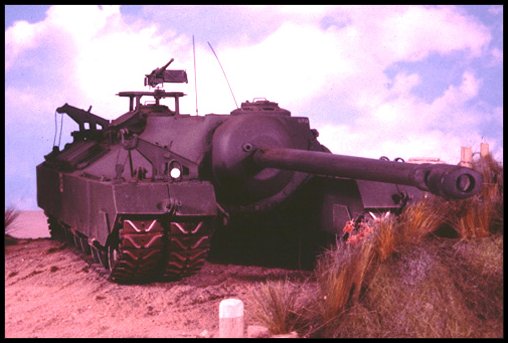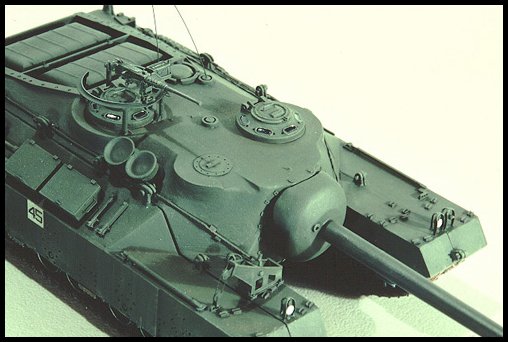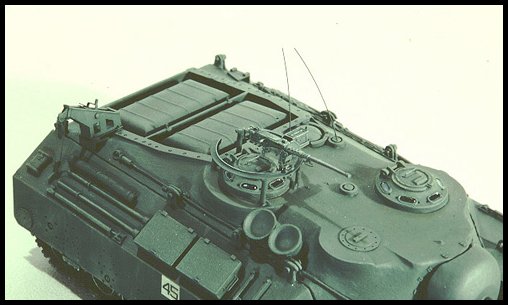

T28 Heavy Tank
Daniel Mitchell

The T28 "Superheavy Tank" is the heaviest armored vehicle ever
produced by the United States ... about 95 tons. Designed
late in WW-II as an assault vehicle to penetrate fixed German defense positions such as
the Siegfried Line, the T28 carries the
thickest armor ever fitted to an armored vehicle ... approx. 12" frontal and 8"
side, some of it well sloped. This is more like
Battleship armor than tank armor! The German's famed 88 mm would be nearly worthless
against such a vehicle.
The T28's turretless design saved a LOT of weight, which allowed much heavier armor to be
fitted. Since the vehicle was
designed for frontal assault, a full rotating turret was not needed. The gun did have
limited traverse in the hull, allowing some
freedom of target choice without turning the whole vehicle. The gun itself was a very-high
velocity 'long' 105mm. Compared
with even the 90mm in the T26 Pershings, this was a powerful weapon; and was sufficient to
'crack' most any target the T28
might encounter.
To speed development, The T28 used as many 'off the shelf' parts as possible. The entire
suspension consisted of slightly
modified M4E8 components. Many of the hull fittings were 'Sherman', as was the Ford V-8
engine and matching transmission.
A much lower final drive ratio was used, to move so heavy a vehicle. Top speed was about
10 mph. The unique paired tracks
gave the vehicle a very acceptable ground pressure not much different than a Sherman. It
weighs three times as much as an M4,
but puts almost three times as much track surface on the ground.

A unique feature of the T28 were the detachable outboard track units. On
each side of the main hull were attached massively
armored supplementary sub-hulls, each with a fully functioning track. These could be
removed from the main hull, clamped
together to form a trailer, and towed behind the T28. This reduced the width to an
acceptable value, allowing the vehicle to
pass through city streets, be rail transported, and to fit in Landing craft. The outboard
units would need to be reattached prior
to combat. Two small moveable cranes are carried by the T28 to assist in
mounting/detaching these side units. Supposedly, a
well trained crew could do this relatively quickly.
One 'dumb' feature are the two very visible brake drums carried on the outside of the T28.
These attach to the track-sprocket
of the outboard track units when they are detached from the vehicle. This weird tracked
trailer had NO regular brakes! To
keep it from overrunning the towing vehicle, crew members, on FOOT, wrapped ropes around
these drums, and pulled! This
created a drag, slowing the trailer. It worked, but won't win any prizes for elegance! Oh,
well, remember that this was only a
prototype vehicle. If it had gone into production perhaps something better would have been
used.
While large, the T28 is smaller than a German 'Maus'. The Maus was designed as a real
'Tank', with full rotating turret, and
heavy armor all around. The price it paid for this was an astonishing weight of about 180
tons, with corresponding lack of
mobility, transport problems, and overloaded drive components! The T28, on the other hand,
was a special purpose vehicle,
with much heavier armor (admittedly only on the front and sides), yet far less overall
weight.
As an assault vehicle, the T28 was formidable. Low and squat, it presented very little
target, and what did show was almost
impenetrable. Only plunging artillery fire and anti-tank mines would much have bothered
it. True, the T28 was SLOW, but this
was not overly important for it's designed purpose. Alone, in open country, the T28 could
be easily avoided or outflanked, but
it was not envisioned to use in such a situation. Imagine, rather, a long row of T28's
assaulting a fixed fortification, well backed
by lesser armor, infantry, artillery, and air support. This was a vehicle to be used from
a position of military superiority, to
'crack' tough spots in a defense perimeter.
Ultimately, it wasn't needed. The Germans abandoned the Siegfried line. Development of the
vehicle continued into the Korean
War years, then was terminated. Briefly, the vehicle was reclassified as a Gun Motor
Carriage, T95, then back as a tank, type
T28. Surviving records (at the time) indicated that both prototypes had been destroyed or
scrapped. Obviously, this was
wrong, as the Patton Museum's example clearly demonstrates.

I scratchbuilt my 1/35 scale T28 a number of year's ago, before the T28
now at Patton Museum was known to exist. I wrote
an article about this at the time, and it was published in Military Modeler magazine.
Since then, Challenge Publications has
re-published the article twice more, most recently with new layout and photos
(unfortunately without correcting factual errors in
the text ... the result of a real T28 being found). The model has won several prizes in
local and regional competitions.
When first built, I worked from a couple poor photos and the drawings in the Bellona Print
pamphlet covering the T28. These
are now hard to find, but an internet query might turn one up. They're fairly accurate,
but not very detailed. I photo-enlarged the
plans up to 1/35, saving multiple scalings of each part.
Some years after I'd built the model, and had the article published, the Army 'found' a
T28, lost in the woods in Virginia for
nearly 40 years, they took it to the Patton Museum in Kentucky. Who but the Army could
'lose' a thing this size? As soon as I
heard about one surviving, I arranged a visit to the museum, took a bunch of photos, and
then rebuilt the model. Originally, I
had to make a number of 'guesses' on various items, and I now had the information to
correct the errors.
A more recent reference is Hunnicut's book "Firepower", a history of American
Heavy tanks. There is a plan, and more photos
of the T28 than in any other source. I recommend it highly, but it's not cheap! There's
also some nice movie footage of a T28
running obstacles on some test track ... it's showed up on several 'armor' TV segments and
on the specialty TV channels
recently.
Currently the model has resin molded suspension parts mastered from modified early Tamiya
M4E8 parts ... not bad, but
certainly not "state of the art" either. I intend to rebuild the model again,
using the DML M4E8 suspension parts, and individual
link tracks. It takes THREE Shermans to provide enough track parts for one T28!
The T28 is actually not too difficult a subject ... there's just a LOT of it. The hull is
a nearly rectangular box. The sloped
surfaces are mostly flat, with only a few curved and 'sculptured' areas. There are NO
louvers on the engine deck (Whee!) ...
just two large, segmented armored hatch covers. A lot of the hull fittings, including
hatches are modified M4 parts. Compared
to a 'scratch' M103 I did more recently, the T28 was EASY!
The most difficult part is getting the armor of the outboard track units to mate properly
to the hull. After completing the framing
and hull 'box', I temporarily assembled the three parts of the hull, added the major
sloped flat plating, then sawed the plating
apart along the hull separation lines, thus assuring that the various 'facets' of the
plating would line up with one another.
I have one more error to correct. None of my earlier references showed the INSIDE of the
outboard track units. You can't see
these at Patton either, since their example is assembled. Hunnicut's book has a photo that
shows this ... the units are mostly
HOLLOW, and open on the inside faces. I have to cut mine open to match ... not too
difficult as they are hollow inside, but
lack the openings.
| Main | What's New | Articles | Reviews | Gallery | Think Tank | Contests |